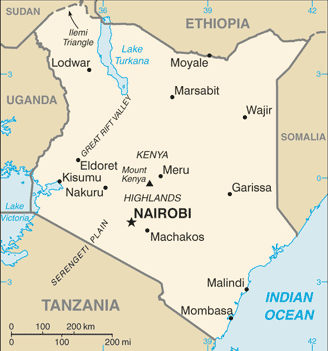Kenya: Difference between revisions
imported>Denis Cavanagh (Stub (albeit, a rather large one)) |
imported>Denis Cavanagh No edit summary |
||
| Line 1: | Line 1: | ||
{{subpages}} | {{subpages}} | ||
[[Image:Ke-map.gif|right|thumb|350px|{{#ifexist:Template:Ke-map.gif/credit|{{Ke-map.gif/credit}}<br/>|}}]] | |||
'''The Republic of Kenya''', or '''Kenya''' is a country in Eastern Africa. It shares borders with [[Ethiopia]], [[Somalia]], [[Tanzania]], [[Uganda]] and [[Sudan]]. Its coastline borders the [[Indian Ocean]]. | '''The Republic of Kenya''', or '''Kenya''' is a country in Eastern Africa. It shares borders with [[Ethiopia]], [[Somalia]], [[Tanzania]], [[Uganda]] and [[Sudan]]. Its coastline borders the [[Indian Ocean]]. | ||
Revision as of 16:32, 4 January 2008
The Republic of Kenya, or Kenya is a country in Eastern Africa. It shares borders with Ethiopia, Somalia, Tanzania, Uganda and Sudan. Its coastline borders the Indian Ocean.
Government
Kenya is governed by a Presidential representative Republic, where the President acts both as head of State and head of Government. Executive power is wielded by the Government. Legislative power is shared between the government and the National Assembly. The Judiciary acts independently of both legislative and executive organs of government.
Kenya has had a relatively stable political history since independence (Omitting recent political unrest and rioting) It escaped much of the internal tribal warfare and civil war which crippled neighbouring nations such as Ethiopia, Uganda and Somalia. Kenya held elections in December 2002 which were deemed free and fair by international observers. Kenya has until recently been used to describe a recovering Africa free of many of the domestic problems inherent with many of her neighbouring states. The 2002 election heralded a peaceful transfer of power from the Kenya African Union to the National Rainbow Coalition.
The disputed 2007 elections led to wide civil strife with around 180,000 people being displaced and an estimated 350 lost lives. [1]
Geography & Natural History
Kenya elevates from low lying coastal lands along the Indian Ocean to the Highlands in the center of the country. The Kenyan highlands are one of the most productive agricultural regions in Africa. The highlands have one of the highest points in Kenya, Mount Kenya and is also home to a rare specimen to Africa - Glaciers. Mount Kilimanjaro, the highest mountain in Africa lies along the Kenya/Tanzania border.
Kenya enjoys a rich variety of flaura and fauna within its borders; Several Safari parks operate under its jurisdiction and it provides a healthy income in tourism for the nation.
Economy
Immediately following independence Kenya enjoyed a period of economic growth, mainly due to public investment and high levels of foreign investment. From the mid 1970's to 1993, her economic performance declined as a direct result in the downturn in the international agriculture market, poor credit and higher oil prices. In the mid 1990's, Kenya began a economic liberalisation effort in tandem with the International Monetary Fund and the World Bank. This allowed a sharp increase in economic fortunes despite setbacks in the early 21st century. However, the IMF suspended Kenya's Enhanced Structural Adjustment Program due to the government's failure to maintain reforms and curb corruption. [2] Over the following few years efforts at reform were top priority in order to get the IMF back on board. Recent efforts at the highest level has been to combat corruption in government which is believed to be widespread from the local level to the very highest level of government.
Demographics
Kenya's ethnic groups comprise the following; Kikuyu 22%, Luhya 14%, Luo 13%, Kalenjin 12%, Kamba 11%, Kisii 6%, Meru 6%, other African 15% and non-African (Asian, European, and Arab) 1%. [3] Recent elections has seen these groups generally vote along ethnic and tribal lines, but with exceptions. In the cities, such as Nairobi, old ethnic divisions are less stark than in the more traditional countryside.
Kenya's religious groups comprise the following; Protestant 45%, Roman Catholic 33%, Muslim 10%, indigenous beliefs 10% and other 2% [4]
Education
Culture
History
The Portuguese first explored Kenya, but later became a Colonial possession of Omani Arabs and Britain.
